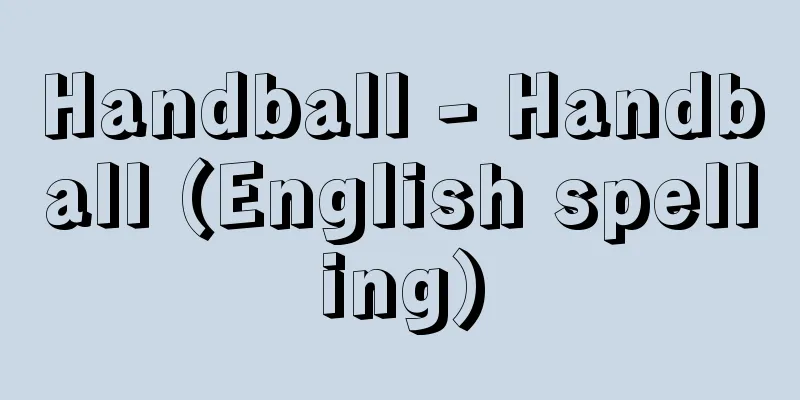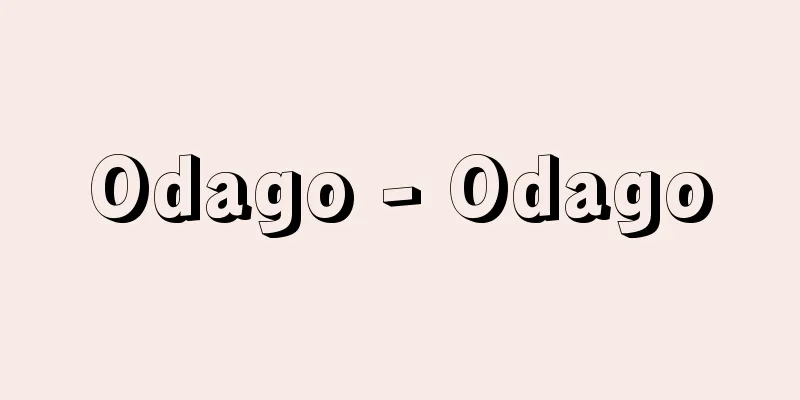Handball - Handball (English spelling)

|
A sport in which two teams pass and dribble the ball to throw it into the opponent's goal, competing for points. In Japan, it was called "soku" until after World War II. There are seven-player (indoor) and 11-player (field) versions, but the 11-player version fell into disuse in the 1960s and has not been played in the World Championships since 1966. Today, both in Japan and overseas, handball refers to the indoor seven-player version. Outdoor seven-player tournaments are held in Europe and Japan in the summer. Japan completely abolished the 11-a-side rugby system in 1963 (Showa 38), and women's and junior high school students had already switched to the seven-a-side rugby system since 1957. The individual sport of hitting a rubber ball against a wall with the open hand and competing for points is also called handball, but there are few enthusiasts of this sport in Japan. In the United States and other countries, "Wall (Irish) Handball" is more popular, and the team ball game handball is called "team handball" or "Olympic handball". In addition, "Beach Handball," a sport played by four people on a team that began on the Adriatic coast of Italy in the late 1980s, has rapidly spread across all continents, with a world championship being held every two years, and it was added to the official events of the World Games (a competition for sports not participating in the Olympics, held the year after the Summer Olympics) in 2013, and was included as an event in the Youth Olympic Games in 2018. The first match was held in Japan in 1997. [Shigeru Sugiyama October 18, 2019] historyIts origins are said to date back to the ancient Greek game of harpasturm, in which a large number of people throw a leather bag filled with feathers into a designated area. The game is similar to the soeur game that became popular in France during the Middle Ages. There are two theories about the origin of modern handball: Denmark and Germany. In 1990, the International Handball Federation (IHF) recognized Denmark as the country where modern handball originated. The first official match in Denmark, called "handbold," was held in Nyborg, a town on the eastern tip of the island of Funen, in the summer of 1898. A rule book published in 1906 and compiled by one of the inventors, physical education teacher Holger Nielsen (1866-1955), still exists. However, Germany was a major player in the international community, working to popularize and develop the game. In 1919, Karl Schlenz (1890-1956) of Germany compiled the "Rules of Handball," unifying similar ball games played in various countries, and published them in 1920 under the name of the Berlin Gymnastics Federation. Handball in Germany was invented around 1915, based on a ball game popularly known as "Raffball" and a women's ball game called "Torball." In 1921, the first competition based on these rules was the first German Championship, held in Hannover, and the sport spread to other European countries. In 1928, at the 9th Olympic Games in Amsterdam, the International Amateur Handball Federation (IAHF) was formed by the International Association of Athletics Federations (IAHF) with 19 countries. Japan's membership application was processed by the IAHF. At the 11th Olympic Games in Berlin in 1936, men's 11-a-side handball was adopted as an official event, but it was not included in subsequent Olympic Games. It was revived as an event at the 20th Olympic Games in Munich in 1972 for the first time in 36 years, when men's seven-a-side (indoor) handball was played, and women's seven-a-side was added and established at the 21st Olympic Games in Montreal in 1976. The rules for seven-a-side handball were established in 1934. The World Championships are held every two years for both men and women. While European athletes continue to dominate the top spots, African athletes are on the rise in the men's competition, and South Korea and Brazil in the women's competition. The International Amateur Handball Federation was reorganized as the International Handball Federation in 1946 after the Second World War. As of July 2019, the number of member countries and regions was 209, including eight associate member countries. [Shigeru Sugiyama October 18, 2019] Japanese HandballIts origins in Japan are said to date back to August 1922 (Taisho 11), when Otani Buichi (1887-1966), a professor at Tokyo Higher Normal School (later Tokyo University of Education, now Tsukuba University), introduced handball at the Japan Society of Physical Education's summer seminar. Otani learned of handball while studying in Europe, and introduced it to the sport after noticing its great physical effects. It was adopted as a teaching material in girls' high schools, middle schools and higher elementary schools in the school gymnastics teaching guidelines of 1926 and 1936 (Showa 11), and became popular, but interest in it as a competitive sport only grew in the latter half of the 1930s. It grew rapidly after being included as an official sport in the 12th Olympic Games scheduled to be held in Tokyo in 1940, and the first Kanto Championship was held in Tokyo in 1937 as the first competition. In February 1938, the Japan Handball Association (the predecessor to the current Japan Handball Association (JHA)) was founded. After the Tokyo Olympics were cancelled, the sport's development slowed down, but after it was included in the National Athletic Meet in 1946 (Showa 21), activities became more active all over the country, and international exchanges were actively carried out from the late 1950s. The seven-a-side version was first shown in 1953, and the eleven-a-side version went into decline due to the influence of trends in Europe and other countries. Japan has participated in the Sevens World Championship since the 4th men's tournament in 1961 and the 2nd women's tournament in 1962. In 2021, the 27th men's tournament was held in Egypt and the 25th women's tournament was held in Spain. The men's team has participated in the Olympics four times: in Munich (1972), Montreal (1976), Los Angeles (1984), and Seoul (1988), while the women's team has participated in Montreal as a representative of the Asian region. The best results were 9th place for the men's team and 5th place for the women's team. Both teams will participate for the first time in a long time in the 2020 Tokyo Olympics (to be held in 2021). As of the end of May 2019, there are about 2,900 teams (high school, technical college, or higher) registered with the Japan Handball Association, with about 61,000 registered players, of which nearly 70% are high school teams and high school students. The Japan Handball Association claims that the total number of players, including elementary school and junior high school enthusiasts, is about 100,000. [Shigeru Sugiyama February 18, 2022] Competition Law, Facilities and Equipment (Sevens)The game is played according to the JHA rules. Each team is made up of 14 players, including substitutes (internationally, up to 16 players are allowed, and it is confirmed that this will increase to 18 players after 2020). A maximum of seven players (one of whom is the goalkeeper) can be on the court at the same time. The six players excluding the goalkeeper are collectively called field players or court players. Each team plays on one side of a rectangular playing field (40m x 20m; the standard for elementary school students is 36m x 20m) divided in half by a centre line. The game starts with one team throwing off from the center, then the team carries the ball by hand passing or dribbling, and competes to throw (shoot) the ball into the opponent's goal (2 meters high, 3 meters wide). The shot is taken from outside the goal area, 6 meters away from the goal. If the throw is successful (goal), one point is awarded, and the team with the most goals within the specified time wins. The regulation time is 70 minutes for both male and female high school students and above (30 minutes each for the first and second halves with a 10 minute break in between; in some competitions such as the Olympics there is a 15 minute break), 60 minutes for junior high school students (25 minutes each for the first and second halves with a 10 minute break in between), and 40 minutes for elementary school students (called "J Quick Handball") (15 minutes each for the first and second halves with a 10 minute break as standard). If the game is not decided within the time limit, after a 5 minute break, an extension (2 x 5 minutes with a 1 minute break) is played. If the score is still tied, a second extension is played in the same way as the first extension. If there is a further tie, the winner is decided according to the rules of each tournament. The competition is managed by two referees. The balls used are spherical and made of rubber wrapped in natural leather or synthetic material; colorful balls are permitted in keeping with the television era. For boys, the balls weigh 425-475 grams and have a circumference of 58-60 centimeters, for girls and boys (junior high school boys), they weigh 325-375 grams and have a circumference of 54-56 centimeters, and for elementary school students, they weigh 255-280 grams and have a circumference of 49.5-50.5 centimeters. [Shigeru Sugiyama October 18, 2019] Main rules of the competition(1) Handling the ball You can run or walk up to three steps while holding the ball in your hand, but any more than that is a foul (oversteps). You can also hold the ball for up to three seconds, but any more than that is a foul (overtime). You can dribble continuously with one hand, but you cannot bounce the ball, catch it with both hands, and then dribble it again (double dribble) (over the ball). You cannot kick the ball and pass it. You also cannot touch the ball with your lower leg or foot. (2) Actions against an opponent It is legal to use your arms or hands to get the ball, or to knock the ball down with an open hand (a fist is illegal). It is also illegal to block an opponent with your body, but pushing, holding, charging, or throwing yourself in front of an opponent are illegal. (3) Goal Area Rules Only the goalkeeper can enter the goal area. However, if a field player steps into the goal area after throwing the ball, it is permitted as long as it does not cause any disadvantage to the opposing team. There is also no limit to the space above the goal area. (4) Rules for Goalkeepers Goalkeepers can use their whole body to defend, and may use their feet and lower legs when a shot is fired. They may move about with the ball without restriction within the goal area. However, they may not leave the goal area while holding the ball, nor may they bring a ball from outside the area into the area. Goalkeepers may play outside the goal area, but in that case the same rules as field players apply. Players may be substituted freely, at any time and as many times as they like, from a designated location (the substitution line). [Shigeru Sugiyama October 18, 2019] Wall HandballWall handball is a game in which players take turns hitting a ball (rubber or synthetic, about 5.4 cm in diameter) against a wall with their hands wearing cloth or leather gloves, competing for points. The game is played according to the rules of the Japan Wall-Handball Association (JWHA). There are singles, where two players compete, and doubles, where two people compete in pairs, and the first player to reach 21 points wins. It is said to have originated in Ireland, and was introduced to America in the late 19th century, where it became popular. There are two types of games: four-walls and one-wall. In the case of fore-wall, the court has four walls on each side. Points are only counted if the player with the right to serve wins a rally. If the player without the right to serve wins a rally, the player simply gains the right to serve (the right to serve is transferred) and no points are scored. The court is 20 feet (6.1 meters) by 40 feet (12.2 meters). The front wall is 20 feet high. The back wall is recommended to be at least 14 feet (4.3 meters) high. [Shigeru Sugiyama October 18, 2019] "Takano Ryo, Illustrated Coach Handball (1998, Seibido Publishing)" ▽ "Japan Handball Association, 75th Anniversary Commemorative Book (2013)" [Supplementary Material] |Source: Shogakukan Encyclopedia Nipponica About Encyclopedia Nipponica Information | Legend |
|
2チームによりボールをパスとドリブルでつないで相手のゴールに投げ入れ、得点を競う競技。日本では第二次世界大戦後までは「送球」とよばれた。7人制(インドア)と11人制(フィールド)があるが、1960年代に入って11人制は衰微し、世界選手権においても1966年以来休止され、国内外とも現在では、ハンドボールといえば室内球技の7人制をさす。夏季にアウトドアで7人制を楽しむ大会がヨーロッパや日本でも開かれる。 日本が11人制を全廃したのは1963年(昭和38)で、女子と中学生は1957年からすでに7人制に一本化されていた。 ゴムボールを平手で壁に打ち当てて得点を争う個人競技もハンドボールとよばれるが、日本では愛好者が少ない。アメリカなどではこの「ウォール(アイリッシュ)・ハンドボール」のほうが盛んで、団体球技のハンドボールは「チーム・ハンドボール」「オリンピック・ハンドボール」などと名づけられている。 このほか、1980年代後半から、イタリアのアドリア海沿岸で始められた1チーム4人による「ビーチ・ハンドボール」Beach Handballが各大陸で急速に普及、世界選手権が2年に一度開かれているほか、2013年からワールドゲームズ(オリンピックに参加していない種目の競技大会。夏季オリンピックの翌年に実施される)の公式競技に加えられ、2018年にはユースオリンピックの実施競技となった。日本では1997年(平成9)、初の試合が行われている。 [杉山 茂 2019年10月18日] 歴史起源は、古代ギリシアで行われていた「ハルパストム」harpasturmといわれる。羽根を詰めた皮袋を大ぜいの人が決められた場所へ投げ込む競技で、中世にフランスで盛んとなった「スール」も同様な競技である。 近代ハンドボールの発祥については、デンマーク発祥説とドイツ発祥説があったが、国際ハンドボール連盟(IHF:International Handball Federation)は、1990年にデンマークを「近代ハンドボール発祥の国」と認定した。デンマークは1898年夏、「ハンドボルト」handboldの名で初の公式試合を、フュン島東端の町、ニュボーで行ったとされる。考案者の一人である体育教師ホルガー・ニールセンHolger Nielsen(1866―1955)などによって編まれた、1906年刊行のルール・ブックも現存する。しかし国際的にはドイツが普及と発展に努め、大きな力を示した。1919年ドイツのカール・シュレンツKarl Schlenz(1890―1956)が、各国で行われていた類似球技を一つにまとめて「ハンドボール競技規則」を制定、1920年にベルリン体操連盟の名で刊行した。ドイツにおけるハンドボールは1915年ごろ、「ラッフバル」Raff ballの名で親しまれていた球技と、女子用の球技「トーアバル」Tor ballなどを基に考案された。 1921年、この規則による最初の競技会として、ハノーバーで第1回ドイツ選手権が開かれ、ヨーロッパ各国へ普及、1928年の第9回オリンピック・アムステルダム大会時に国際陸上競技連盟により、19か国で国際アマチュア・ハンドボール連盟(International Amateur Handball Federation。略称IAHF)が結成された。日本は陸上競技連盟によって加盟手続きが行われた。 1936年の第11回オリンピック・ベルリン大会では正式競技として男子の11人制ハンドボールが採用されたが、その後のオリンピックでは実施されず、1972年の第20回ミュンヘン大会で36年ぶりに競技種目として復活し、男子の7人制(インドア)ハンドボールが行われ、1976年の第21回モントリオール大会からは女子の7人制も加わり、定着した。7人制のルールは1934年に制定された歴史がある。 世界選手権は男女とも2年に一度行われる。ヨーロッパ勢が上位を独占する時代は続いているが、男子はアフリカ勢、女子は韓国、ブラジルが台頭してきている。 国際アマチュア・ハンドボール連盟は第二次世界大戦後の1946年に国際ハンドボール連盟に改組された。加盟国は2019年7月時点で準加盟国8を含め209の国と地域となった。 [杉山 茂 2019年10月18日] 日本のハンドボール1922年(大正11)8月、日本体育学会夏季講習会で、東京高等師範学校(後の東京教育大学。現、筑波(つくば)大学)教授の大谷武一(ぶいち)(1887―1966)が紹介したのが、日本での端緒とされる。大谷はヨーロッパ留学中にハンドボールを知り、体育的効果の大きさに注目して導入した。1926年と1936年(昭和11)の学校体操教授要目に高等女学校、中等学校や高等小学校の教材として採用され、普及していったが、競技スポーツとして関心が高まったのは1930年代の後半である。1940年東京で予定された第12回オリンピックの実施競技に加わったことで急速な伸びをみせ、1937年最初の競技会として東京で第1回関東選手権が開かれ、1938年2月、日本送球協会(現在の公益財団法人日本ハンドボール協会〈JHA:Japan Handball Association〉の前身)が設立された。オリンピック東京大会の返上で、その後の発展は細々としたものになったが、1946年(昭和21)国民体育大会競技に含まれたことから国内各地での活動が盛んとなり、1950年代後半から国際交流も積極的に行われた。7人制の初公開は1953年で、ヨーロッパなどの流れの影響を受け、11人制は衰退していった。 7人制世界選手権への参加は、男子が1961年の第4回、女子が1962年の第2回大会からである。2021年には男子の第27回大会はエジプトで、女子の第25回大会はスペインで開催された。 オリンピックには、男子はミュンヘン(1972)、モントリオール(1976)、ロサンゼルス(1984)、ソウル(1988)の4回、女子はモントリオールにそれぞれアジア地域代表として出場、男子はモントリオールの9位、女子は同5位が最高の成績である。男女とも2020年の東京オリンピック(2021年開催)で久々の出場を果たした。2019年(令和1)5月末時点で、日本ハンドボール協会への登録チーム数(高等学校、高等専門学校以上)は男女あわせて約2900、登録競技者は約6万1000人、その70%近くが高等学校チームと高校生である。日本ハンドボール協会は小学生、中学生の愛好者を含め、総数を約10万人と称している。 [杉山 茂 2022年2月18日] 競技法と施設・用具(7人制)競技はJHAの競技規則に基づいて行われる。1チームの編成は交代要員を含め14人(国際的には16人まで認められ、2020年以降は18人に増えることが確定している)である。最大で同時に7人の選手(うち1人はゴールキーパー)がコートに出場できる。ゴールキーパーを除く6人を一括してフィールドプレーヤーあるいはコートプレーヤーとよぶ。 相対する2チームは、センターラインで2分された長方形の競技場(40メートル×20メートル。小学生の標準は36メートル×20メートル)の一方を自陣とする。 一方のチームが中央からスロー・オフすることで競技が開始され、手によるパスやドリブルによってボールを運び、相手ゴール(高さ2メートル、幅3メートル)に投げ入れて(シュート)、得点を争う。シュートは、ゴールから6メートル離れたゴールエリアの外側から行う。投げ入れに成功(ゴール)した場合は1点が与えられ、規定時間内にゴール数の多い側が勝ちとなる。 規定時間は、男女とも高校生以上は70分(前半・後半各30分で、間に10分の休憩。オリンピックなどの大会によっては15分の休憩)、中学生男女は60分(前半・後半各25分で、間に10分の休憩)、「Jクイックハンドボール」とよばれる小学生男女は40分(前半・後半各15分で、間に10分の休憩が標準)である。時間内に勝負がつかない場合は、5分間の休憩のあと、延長(5分×2回、休憩1分)を行う。それでも同点の場合は第2延長を、最初の延長と同じ方法で行う。さらに同点の場合は大会ごとの規定で勝者を決める。競技の運営は、2人の審判員が務める。 使用ボールは球形で天然の皮革あるいは合成の材質で包まれたゴムでできており、テレビ時代に即したカラフルなボールも認められている。男子が重さ425~475グラム、外周58~60センチメートル、女子と少年(中学生男子)は重さ325~375グラム、外周54~56センチメートル、小学生は重さ255~280グラム、外周49.5~50.5センチメートルである。 [杉山 茂 2019年10月18日] 競技のおもな規則(1)ボールの扱い ボールを手に持ち3歩まで走ったり歩いたりできるが、それ以上は反則(オーバー・ステップoversteps)。また、ボールを3秒までは手に持ったままでよいが、それ以上は反則(オーバー・タイムovertime)。片手で連続してドリブルdribbleするのはよいが、弾ませたボールを両手でとらえたあと、ふたたびドリブルする(ダブルドリブル)のは許されない。ボールを蹴ってパスしてはいけない。また、ボールに下腿(かたい)、足で触れてはいけない。 (2)相手に対する動作 ボールを得るために腕や手を使うことや、開いた片手で相手の持つボールをたたき落とすことはよい(こぶしは反則)。また、相手を自分の身体で阻止することは許されるが、押す(プッシング)、つかまえる(ホールディング)、突き当たる(チャージング)、相手の前に身体を投げ出す(トリッピング)のは反則である。 (3)ゴールエリアの規則 ゴールエリアはゴールキーパーだけが入れる。ただし、フィールドプレーヤーがボールを投げたあとに踏み入った場合、それが相手側へなんの不利益も与えないときは許される。また、ゴールエリア上の空間に制限はない。 (4)ゴールキーパーの規則 ゴールキーパーは全身であらゆる防御ができ、シュートされた場合には足や下腿を使ってもよい。ゴールエリア内においては、ボールを制限なく持って動くことができる。しかし、ボールを持ったままゴールエリア外に出てはならないし、エリア外のボールをエリア内に持ち込んでもいけない。ゴールキーパーはゴールエリアの外でもプレーできるが、その場合はフィールドプレーヤーと同じ規則が適用される。選手の交代は自由で、規定された場所(交代ライン)から、いつでも何回でも行える。 [杉山 茂 2019年10月18日] ウォール・ハンドボールwall handball 布または皮革製のグラブをはめた手で、ボール(ゴムまたは合成素材で直径約5.4センチメートル)を壁に交互に打ち返して、得点を争うゲーム。競技は日本ウォールハンドボール協会(JWHA:Japan Wall-Handball Association)の競技規則に基づいて行われる。二人が競い合うシングルスと、二人一組で対戦するダブルスがあり、21点を先取したほうが勝ちとなる。発祥地はアイルランドといわれ、19世紀後半にアメリカに伝わり盛んになった。 競技は、一般的にフォア・ウォール・ゲームfour-walls gameと、ワン・ウォール・ゲームone-wall gameの2種類で、フォアの場合は、前後左右に四つの壁をもったコートで行われる。得点はサーブ権をもった選手がラリーで勝った場合のみカウントされ、サーブ権をもたない側がラリーに勝った場合はサーブ権を得る(サーブ権が移る)だけで得点とはならない。 コートの広さは20フィート(約6.1メートル)×40フィート(約12.2メートル)。フロント・ウォールとよばれる前面の壁は20フィートの高さ。バック・ウォールという後面の壁は少なくとも14フィート(4.3メートル)の高さであることが推奨されている。 [杉山 茂 2019年10月18日] 『高野亮著『図解コーチ・ハンドボール』(1998・成美堂出版)』▽『日本ハンドボール協会編・刊『日本ハンドボール協会創立75周年記念誌』(2013)』 [補完資料] |出典 小学館 日本大百科全書(ニッポニカ)日本大百科全書(ニッポニカ)について 情報 | 凡例 |
Recommend
Stefan Dušan
1308‐55 Serbian king of the Middle Ages (1331-45),...
Minoshima
The central area of Arita City, northwest of Wak...
Standard light source
A light source specified for use when observing t...
Maeda Seison
Japanese painter. His real name was Renzo. He was...
Niyodo [village] - Niyodo
A village in Takaoka County, in the mid-west of Ko...
Nagaoka [city] - Nagaoka
A city in central Niigata Prefecture. It was incor...
corpusculum renis
… The external shape also differs depending on th...
Cassiodorus, Flavius Magnus Aurelius
[Born] 490. Southern Italy, Brussels, Scyllaceum [...
Lobster claws
A small perennial plant of the Bromeliaceae family...
Progressive Giant Bulla
…Alveolar cysts are formed when adjacent alveoli ...
Seki clan
A medieval samurai family. (1) A clan of the Okata...
Tatejamisen
〘Noun〙 (also "tate shamisen") In an ense...
Kanie [town] - Kanie
A town in Ama County, western Aichi Prefecture. Lo...
Easterly wind - Hentofu
Although it has a northerly or southerly componen...
Petition - Moushibumi
〘Noun〙① A name for the style of ancient documents,...









